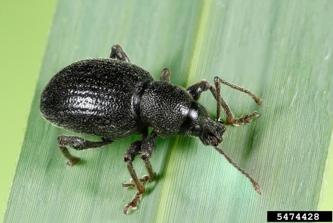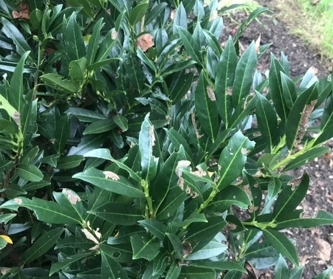Otiorhynchus sulvatus (F.)

The black vine weevil, also known as the Taxus weevil, has become a serious pest in nurseries across the northern United States since its introduction from Europe approximately 150 years ago. It has a wide range of host plants including: Taxus (yew), rhododendron, hemlock, azalea, euonymus, cyclamen, laurel, gardenia, juniper, impatiens, boxwood, holly, grape, strawberry and various other woody and herbaceous plants.
Black vine weevils have one generation per year (more if in a greenhouse). The adult weevils are all flightless female beetles that disperse only by crawling. Males are not known to occur and females produce eggs without mating. The 5/8" weevils are black with light yellowing or gray spotting or checkering on their backs.
Research by Dr. James Hanula, Connecticut Agricultural Experiment Station, New Haven, has determined that adults emerge from the soil from late May to early June but do not begin to lay eggs until three to four weeks after emergence. Foliar insecticidal sprays should be used at this time as the adult female will feed until she begins to lay eggs.
Damage
The adults feed at night on the foliage of host plants causing crescent- or notch-shaped injuries along the margins of leaves and needles. The notching of the leaves is much less serious than the injury caused by the grubs (larvae) feeding on the roots. Adults hide during the day in leaf litter, other debris or soil under the plants. Black vine weevils overwinter in the soil as larvae or as adults in plant debris, buildings or other sheltered areas.

The adults tend to be more abundant after wet summers and are commonly found in and around houses, being attracted to lights. They do not cause a household problem indoors other than their presence.
Eggs are laid in the soil at the base of host plants and hatch into larvae in about 10 days. The larvae are legless, slightly C-shaped white grubs with brown heads. Larvae feed on the roots of host plants and in heavy infestations may destroy most of the small feeder roots. Larger roots and the crown may be girdled (removal of the bark in a ring) resulting in wilting, yellowing of foliage, and possible death of the plant.
Monitoring
Plants should be examined very carefully before purchase to detect notching of the leaves. Plants showing signs of adult feeding should not be purchased because larvae may be in the soil of the root ball. Many infestations of black vine weevil are the result of purchasing infested plants. If controls are needed, they are best directed at the adults to kill them before they lay eggs. Larvae are usually found deep in the root ball and cannot be reached well with an insecticide to provide good control.
Susan Mulgrew, University of Massachusetts, Amherst, has developed a method of monitoring black vine weevil adults using burlap traps. In early May a piece of burlap, approximately four feet by three feet, is bunched lengthwise to create folds and then is wrapped around the base of a host plant. The adult weevil will crawl into the folds of the cloth to hide during the day. The traps can be inspected by gently removing the burlap and examining it for weevils.
Controls
The beneficial nematodes in the Steinernematidae and Heterorhabditidae families should be applied in April-May or in late August-early September when the larvae are active in the soil. Follow all directions for the application of the nematodes as they must stay moist in order to be fully effective. Do not use Neem oil products in conjunction with nematodes as the Neem will act as a repellent.
As the adults feed at night, they are difficult to control using a contact insecticide although scouting and hand-picking are options. A sheet or burlap spread beneath the plant will catch the adults as they drop to the ground. Beetles caught in the burlap should be destroyed.
Despite good cultural practices, pests and diseases at times may appear. Chemical control should be used only after all other methods have failed. For pesticide information please call UConn Home and Garden Education Center or your local cooperative extension office.
The UConn Home & Garden Education Center supports UConn Extension’s mission by providing answers you can trust with research-based information and resources. For gardening questions, contact us toll-free at (877) 486-6271, visit our website at homegarden.cahnr.uconn.edu, or reach out to your local UConn Extension center at cahnr.uconn.edu/extension/locations.
Revised by the UConn Home & Garden Education Center, 2020.